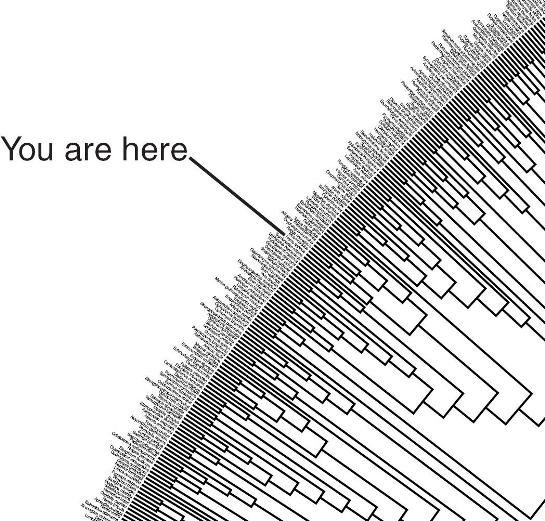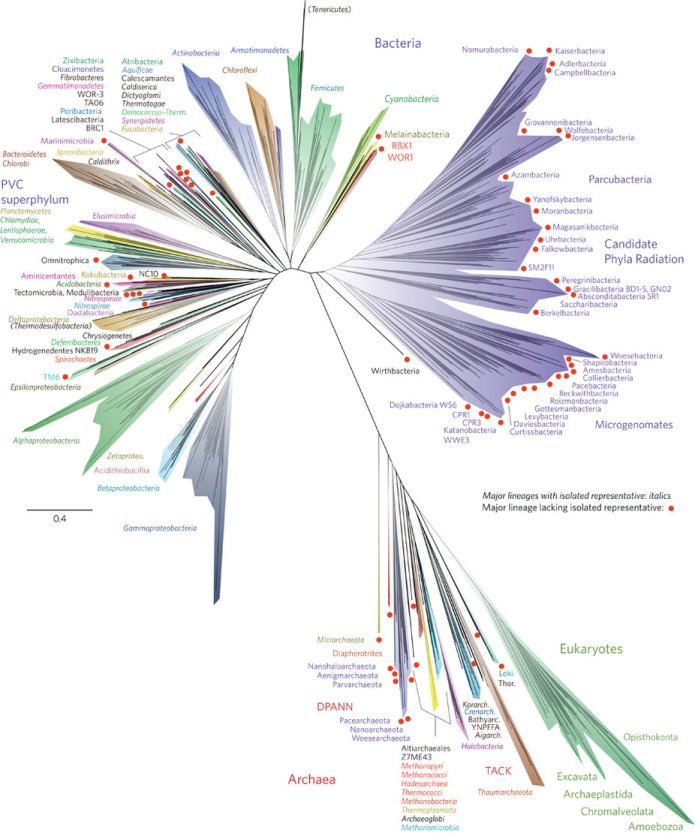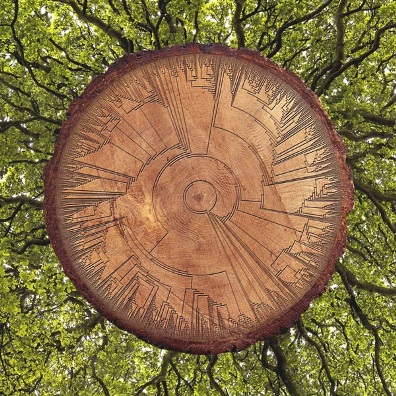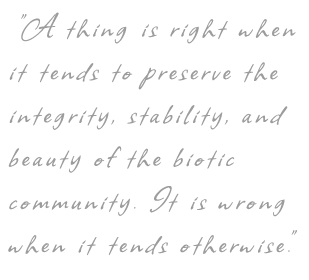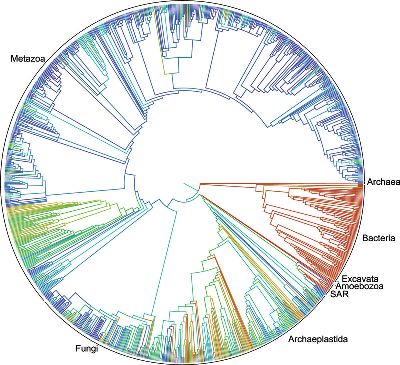Tree of Life
An open source 'Tree of Life' including all species known to humans to date
U.S. National Science Foundation / September 2015
First draft of ‘Tree of Life’ data diagrams include 2.3 million species
http://www.eurekalert.org/pub_releases/2015-09/uom-ol091815.php
http://www.pnas.org/content/early/2015/09/16/1423041112
Authors of the Study
Scientists have used gene sequences and morphological data to construct tens of thousands of evolutionary trees (phylogenetic schematics) that describe the evolutionary history of animals, plants, and microbes. This study is the first, to our knowledge, to apply an efficient and automated process for assembling published trees into a complete tree of life. This tree and the underlying data are available to browse and download from the Internet, facilitating subsequent analyses that require evolutionary trees. The tree can be easily updated with newly published data. Our analysis of coverage not only reveals gaps in sampling and naming biodiversity but also further demonstrates that most published phylogenies are not available in digital formats that can be summarized into a tree of life.
http://www.pnas.org/content/early/2015/09/16/1423041112.full.pdf
The realization that all organisms on Earth are related by common descent was one of the most profound insights in scientific history. The goal of reconstructing the tree of life is one of the most daunting challenges in biology. The scope of the problem is immense... most species have yet to be described. Despite decades of effort and thousands of phylogenetic studies on diverse clades, we lack a comprehensive tree of life, or even a summary of our current knowledge. One reason for this shortcoming is lack of data. GenBank contains DNA sequences for 411,000 species, only 22% of estimated named species. Although some gene regions have been widely sequenced across some lineages, they are insufficient for resolving relationships across the entire tree. Most recognized species have never been included in a phylogenetic analysis because no appropriate molecular or morphological data have been collected...
○ ○ ○ ○ ○ ○ ○ ○ ○ ○ ○
Also See
http://blog.eol.org/ -- https://twitter.com/eol
https://www.flickr.com/groups/encyclopedia_of_life
and
April 2015
NYT: Scientists Unveil New ‘Tree of Life’
http://www.nature.com/articles/nmicrobiol201648
○ ○ ○ ○ ○ ○ ○ ○ ○ ○ ○ ○ ○ ○ ○ ○ ○ ○ ○ ○ ○ ○ ○ ○ ○ ○ ○ ○
September 20, 2015 (ENS - Environment News Service)
- The relationships among living things, as they diverged from one another from the beginning of life on Earth more than 3.5 billion years ago, are shown for the first time in a comprehensive Tree of Life... It is now available free online for anyone to use or edit, something like a Wikipedia for evolutionary trees.
○
The current version of the Tree with underlying data and source code is available to browse and download at: https://tree.opentreeoflife.org
Treemachine
View at GitHub / OpenTreeofLife -- https://github.com/OpenTreeOfLife/treemachine
The open source framework facilitates community comment and contribution, enabling the tree to be continuously updated when new phylogenetic and taxonomic data become digitally available...
Principal investigator Karen Cranston of Duke University said, “This is the first real attempt to connect the dots and put it all together. Think of it as Version 1.0”...
Next steps in multiplying the research
#OpenAccess - https://twitter.com/hashtag/openaccess?src=hash
○ ○ ○ ○ ○ ○ ○ ○ ○ ○ ○ ○ ○ ○ ○ ○ ○ ○ ○ ○ ○ ○ ○ ○ ○ ○ ○ ○ ○ ○ ○ ○
https://www.youtube.com/watch?v=Ew-6WuTo1Is
○ ○ ○ ○ ○ ○ ○ ○ ○ ○ ○ ○ ○ ○ ○ ○ ○ ○ ○ ○ ○ ○ ○ ○ ○
Dimensions of Biodiversity Program / NSF
Despite centuries of discovery, most of our planet's biodiversity remains unknown. The scale of the unknown diversity on Earth is especially troubling given the rapid and permanent loss of biodiversity across the globe. The goal of the Dimensions of Biodiversity campaign is to transform, by 2020, how we describe and understand the scope and role of life on Earth.
http://www.nsf.gov/pubs/2014/nsf14057/nsf14057.pdf
The innovative and interdisciplinary teams of the Dimensions of Biodiversity program “may accomplish in 10 years what, with a piecemeal approach, would have taken 50 years—a half century we can no longer afford to wait.”
- Dr. Joann P. Roskoski, NSF Deputy Assistant Director for Biological Sciences
○ ○ ○ ○ ○ ○ ○ ○ ○ ○ ○ ○ ○ ○ ○ ○ ○ ○ ○ ○ ○ ○ ○ ○ ○ ○ ○ ○ ○
NSF BIODIVERSITY STREAMS OF ACTIVITY - 2020 GOALS
*Research -- An integrated understanding of the key but unknown dimensions of biodiversity on earth
*Cyberinfrastructure -- Informatics and infrastructure that support accessible, interoperable information capability for dimensions of biodiversity
*Collections -- Digitization of collections and enhanced physical infrastructure to link to cyberinfrastructure and leverage the enormous investments of the past
*Workforce -- A diverse, interdisciplinary, globally-engaged, scientific workforce capable of transforming and communicating our understanding of biodiversity on Earth
*Synthesis -- Scientific analyses and syntheses that generate and disseminate useful information for scientists, educators and decision makers
○ ○ ○ ○ ○ ○ ○ ○ ○ ○ ○ ○ ○ ○ ○ ○ ○ ○ ○ ○ ○ ○ ○ ○ ○ ○ ○ ○ ○
As of 2014, projects funded by the Dimensions of Biodiversity Program are required to format and deposit phylogenetic character matrices and trees within the Open Tree of Life Project...
Program Title:
Dimensions of Biodiversity
Synopsis of Program:
Despite centuries of discovery, most of our planet's biodiversity remains unknown. The scale of the unknown diversity on Earth is especially troubling given the rapid and permanent loss of biodiversity across the globe. With this loss, humanity is losing links in the web of life that provide ecosystem services, forfeiting an understanding of the history and future of the living world, and losing opportunities for future beneficial discoveries in the domains of food, fiber, fuel, pharmaceuticals, and bio-inspired innovation.
The goal of the Dimensions of Biodiversity campaign is to transform, by 2020, how we describe and understand the scope and role of life on Earth. The campaign promotes novel, integrated approaches to identify and understand the evolutionary and ecological significance of biodiversity amidst the changing environment of the present day and in the geologic past.
This campaign seeks to characterize biodiversity on Earth by using integrative, innovative approaches to fill the most substantial gaps in our understanding of the diversity of life on Earth. It takes a broad view of biodiversity, and currently focuses on the integration of genetic, taxonomic/phylogenetic, and functional dimensions of biodiversity. Successful proposals should integrate these three dimensions to understand interactions and feedbacks among them. While this focus complements several core NSF programs, it differs by requiring that multiple dimensions of biodiversity be addressed simultaneously, in innovative or novel ways, to understand their synergistic roles in critical ecological and evolutionary processes.
○ ○ ○ ○ ○ ○ ○ ○
○ ○ ○ ○ ○ ○ ○ ○ ○ ○ ○ ○ ○ ○ ○ ○ ○ ○ ○ ○ ○ ○ ○ ○ ○ ○ ○ ○ ○
Natural Resources and Intrinsic, Integral Ecology
SJS / GP360 Siterunner: Essentially, the value of biodiversity extends far beyond the US National Science Foundation enumerated research goals of "beneficial discoveries" for "food, fiber, fuel, pharmaceuticals and bio-inspired innovation". We speak of "Natural Capital", of the natural resources of Earth even as biodiversity on Earth has value inherently, an intrinsic value in and of itself, in ways seen and utilized as resources in human activity -- and in ways unseen and vital beyond human economic activity. An "integral ecology" speaks to larger issues of interconnectedness, resilience and survivability over time. The biosphere and environmental security are integrally connected and life on Earth must be protected for future generations.
○ ○ ○ ○ ○ ○ ○ ○ ○ ○ ○ ○ ○ ○ ○ ○ ○
Tree of Life / Wikipedia citations
'The Tree of Life Project - Related History
Tree of Life Media: Images, Movies, Sounds
○ ○ ○ ○ ○ ○ ○ ○ ○ ○ ○ ○ ○ ○ ○ ○ ○ ○ ○ ○ ○ ○ ○ ○ ○ ○ ○ ○ ○
http://www.greenpolicy360.net/w/File:Tree_of_Life_video.png
http://www.greenpolicy360.net/mw/images/You_are_here_on_the_cladogenetic_tree.jpg
- Agriculture
- Animals
- Biodiversity
- Biogeosciences
- Biosphere
- Climate Change
- Earth Science
- Earth Law
- Ecological Economics
- Eco-Spirituality
- Ecology Studies
- Endangered Species
- Environmental Full-cost Accounting
- Environmental Laws
- Environmental Protection
- Evolutionary Biology
- Extinction
- Fisheries
- Forests
- Green Values
- Land Ethic
- Microbiology
- Microorganism
- Natural Capital
- Natural Resources
- Natural Resource Economics
- Oceans
- Ocean Science
- Ocean Sustainability
- Open Access
- Rights of Nature
- Seventh Generation Sustainability
- Sustainability
- Sustainability Policies
- Wetlands
- Zoology
